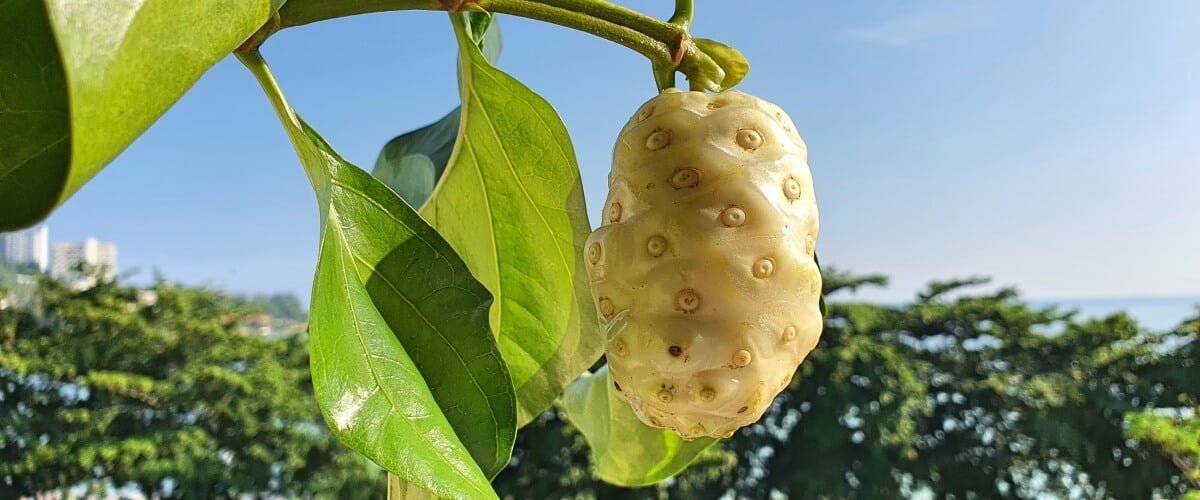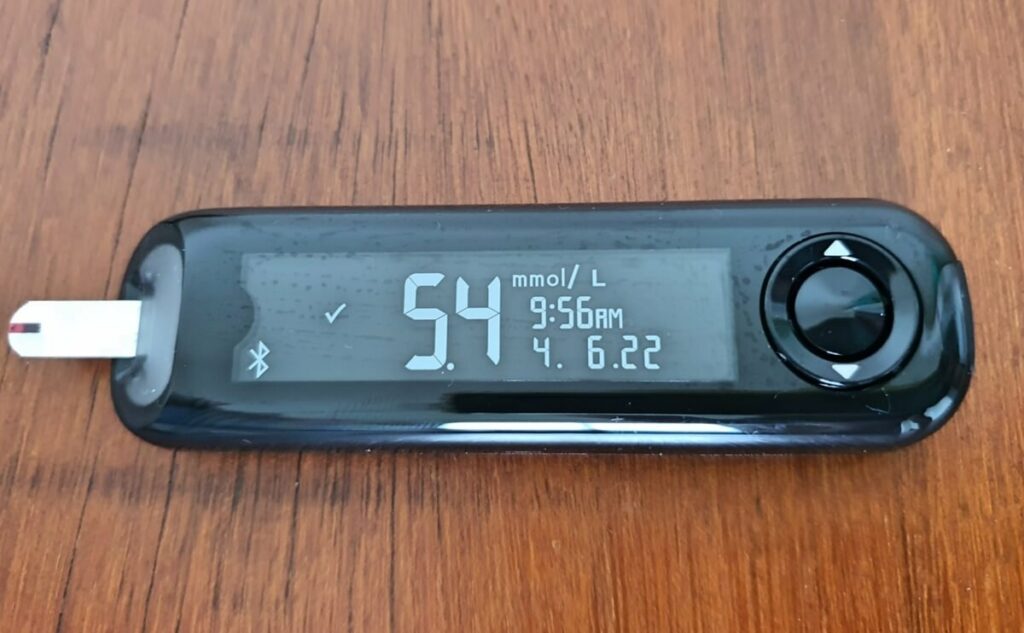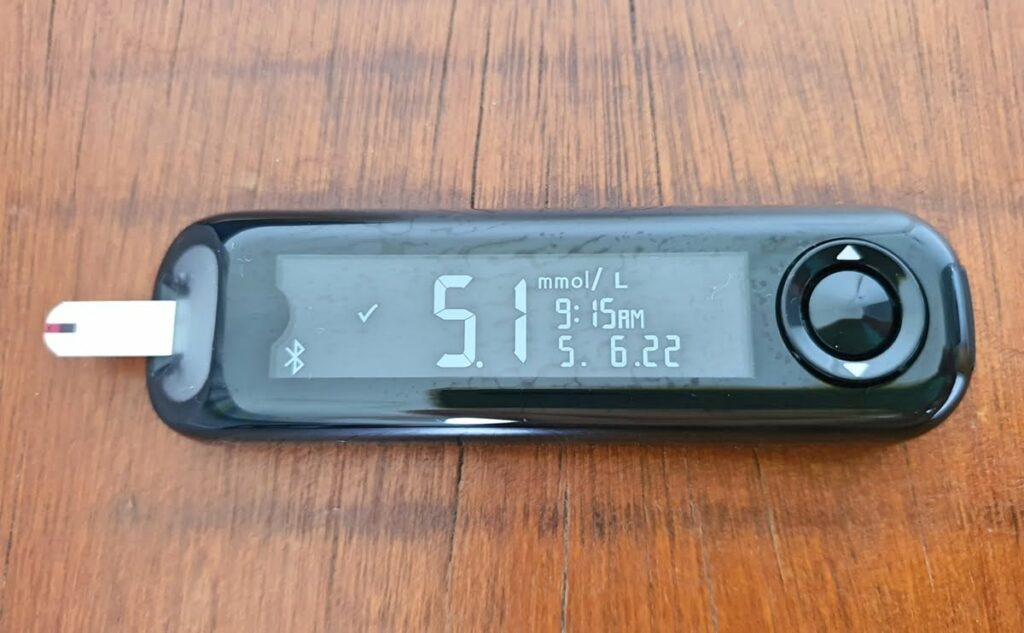Will Regular Consumption of Noni Fruit Lower My Blood Glucose Levels?
As a trial, I added noni fruit to my daily diet at the end of May 2022 to lower my blood sugar levels and perhaps stall progression to prediabetes.

Noni (Morinda citrifolia) is a tree we sometimes see on Penang island, by the roadside, or in people’s gardens.
I’ve infrequently eaten the noni fruit (which I will call “noni” for the rest of this blog post) since I first came across it 16 years ago because the local markets or shops don’t sell it, and I don’t like the taste and smell of the fruit. The last time I ate noni was in December 2017. I hadn’t considered eating it again until recently.
I started eating the equivalent of one medium-sized noni daily on May 29, 2022, i.e., seven days ago.
Impaired Glucose Tolerance
Allow me to give some background to provide context.
Fasting Blood Glucose Level: Different Laboratory and Home Measurements
Three laboratory-based fasting blood glucose (sugar) tests between July 2021 and March 2022 were at or above the American Diabetes Association’s cut-point for prediabetes.
However, the four subsequent fasting blood glucose levels, measured with my home glucose meter, were below the 5.6 mmol/L (100 mg/dL) threshold for diagnosing prediabetes, i.e., the levels were normal.
| Date of test | Fasting blood glucose (mmol/L) | Type of Test |
|---|---|---|
| 07/06/2021 | 5.6 | Laboratory |
| 10/05/2021 | 5.6 | Laboratory |
| 03/29/2022 | 5.8 | Laboratory |
| 04/12/2022 | 5.2 | Home glucometer |
| 04/14/2022 | 5.2 | Home glucometer |
| 06/04/2022 | 5.4 | Home glucometer |
| 06/05/2022 | 5.1 | Home glucometer |
Seven-Week Interval Between Fasting Blood Glucose Measurements to Build Muscle Mass
As you can see in the table above, there was a 7-week interval between home glucometer readings, i.e., between April 14 and June 4. I had a few tests of change planned in April, and I have followed through on most of them. For example:
- I resumed running. My runs’ duration and intensity have progressively increased over the weeks. I now run 6.8 km in 43 minutes once or twice a week.
- Likewise, I have escalated the time I spend on the ergometer (indoor rower) – I now row for about 50 minutes two or three times a week.
- Light calisthenics in the past several weeks have increased my core muscle strength and stability.
- I’m consuming half a bitter melon at least twice every week.
- My sleep duration has increased.
I didn’t think I would see an improvement in my fasting blood glucose level until I had implemented some of these changes for a few weeks, so I didn’t bother to measure it.
Although the initial idea was to test the changes, I had to implement some (e.g., running, rowing, developing my core muscles, and sleeping more hours) in the long term, regardless of whether I saw tangible results because these changes were science-based.
One consequence of running and rowing, and more sleep, is a noticeable increase in muscle bulk. I had lost muscle size during the months in which the only exercise I was getting was walking or stair climbing only. Left-sided sciatic symptoms had restricted me to those exercises. The muscles in my upper body, in particular, are more prominent.
Surprisingly High Blood Glucose Level Reading on June 4, 2022
While preparing to write this post, I decided it was time to recheck my fasting blood glucose.
So, I measured my fasting blood glucose yesterday morning (June 4, 2022).
To my surprise, it was 5.4 mmol/L or 98 mg/dL, higher than the two previous fasting levels, which I obtained using the same equipment and process.

With the increase in muscle mass and after making a few changes to my sleep pattern and diet, I expected the level to be the same or lower, not higher. Besides being surprised, I couldn’t help feeling disappointed and concerned that I was inching towards being a full-blown diabetic.
There were a few potential reasons for my blood glucose level moving in the wrong direction, e.g.:
- After prolonged COVID-19-related restrictions, the reopening of the economy and the consequent change in my work schedule threw my daily intermittent fasting routine out of kilter.
- I was fasting between 10 and 12 hours only on most days. I had been fasting for at least 15 hours per day previously.
- In the past week, I had consumed more carbohydrates. My wife had developed an allergy to multiple foods. So, to clear the food stored in the fridge that she could not eat, she used it to make mid-afternoon “snacks,” e.g., pancakes, curried potatoes, and biscuits. I have also eaten bread for my late afternoon tea on some days in the last fortnight. I had stopped this practice for reasons I cannot remember a few months ago.
- I habitually nibbled on various foods available in the kitchen, e.g., raisins, bananas, nuts, and biscuits. Though the amount was not significant, the additional carbohydrate in my diet might have adversely affected my body’s insulin sensitivity.
- Anxiety over the glucometer result.
Troubled by the 5.4 mmol/L reading yesterday, I reduced the table sugar I usually add to the morning coffee from 2 teaspoons to 1.5 teaspoons. I skipped the usual afternoon tea and had no sweetened tea, which I would typically take twice a day, i.e., at afternoon tea and during the day’s main meal.
I went out for a 30-minute walk in the neighborhood yesterday afternoon. In the evening, I ran 8 kilometers in 50 minutes. I had dinner (my main meal of the day) at about 8 p.m.
Improved Blood Glucose Level Reading on June 5, 2022
Unconvinced by the 5.4 mmol/L reading yesterday, I repeated the fasting blood glucose test with my glucometer this morning. The result was as surprising as yesterday’s but, this time, in a good way. 5.1 mmol/L.

I doubt today’s result was because of yesterday’s calorie and simple sugar reduction. Nonetheless, I will go without afternoon tea and reduce my table sugar consumption in the coming week to see if my fasting blood glucose remains at 5.1 mmol/L or lower. I would probably have made more drastic modifications to my diet if today’s result was 5.2 mmol/L or higher. I use 5.2 mmol/L as a reference because that was the level I got when I first measured my fasting blood glucose level with the current glucometer.
One plausible explanation for my fasting blood sugar level being higher yesterday than today was that I felt tense in anticipation of the glucometer reading yesterday.
Measurement error in the device and inter-day glycemic variability are other potential causes.
A person whose actual blood glucose level is “high” cannot have a “low” reading unless the device is unreliable. A person with a “low” blood glucose level may have an erroneous “high” reading because the device is defective, or the person is anxious, e.g., white-coat hyperglycemia or something similar. My glucose meter, a Contour Next One, was brand new when I got it two months ago; it is unlikely to be defective. Using this rationale, I feel encouraged by the 5.1 mmol/L reading.
Glycated Hemoglobin (HbA1c)
My glycated hemoglobin (HbA1c) on October 5, 2021, was 5.0%. The American Diabetic Association’s threshold for diagnosing prediabetes is 5.7%. So, my HbA1c in October 2021 was in the range expected in someone with normoglycemia (no prediabetes).
I have not had another HbA1c test since October of last year.
Diagnostic Uncertainty
Therefore, it is uncertain if I have prediabetes.
The in-laboratory fasting blood glucose tests in June 2021 and March 2022 suggest prediabetes. Since April, the fasting blood glucose levels taken with my home glucometer have been below the threshold to diagnose prediabetes. My HbA1c in October 2021 was normal.
Because of the diagnostic uncertainty and my belief that my fasting glucose levels should be lower than those measured by my home glucometer (despite being normal), I am determined to lower my blood sugar levels by non-pharmacological means.
Addition of Noni Fruit to My Diet
Last week, it suddenly dawned on me I should try adding noni to my diet to lower my blood sugar.
Why I Am Eating Noni Regularly
People have used noni in traditional medicine to treat or prevent various medical conditions. I won’t go through the long list of purported health benefits of noni in this post. Instead, I’ll only discuss why I added noni to my regular diet.
Noni Has Anti-Diabetic Potential
Noni has been used to treat diabetes in traditional and modern alternative medicine.
Some studies have shown that fermented noni juice can lower blood glucose levels in diabetic rats. However, the scientific evidence to support the fruit’s diabetic-preventing activity in normoglycemic persons or its glucose-lowering ability in diabetic patients is lacking.
Ingesting One Noni Fruit per Day Is Probably Safe
There are anecdotal case reports of hepatotoxicity. However, these reports have been rare and appear to be associated with persons “who have a particular sensitivity for hepatotoxic effects to noni fruit products.”
The European Food Safety Authority recognized noni fruit puree and concentrate as a novel fruit ingredient in 2009.
Based on the information I have read on the topic, I believe eating one noni per day is probably safe in my case. The only medication I regularly take is mesalazine (also known as mesalamine or 5-aminosalicylic acid (5-ASA)), 3 grams daily. Mesalazine is metabolized in the liver and has the potential to cause mild-to-moderate liver injury. Therefore, I still have to be careful consuming noni because there is a higher risk of liver toxicity eating it while taking mesalazine than eating the fruit alone without being on any regular medication.
How I Consume Noni
I’ve been eating noni whole instead of juicing it because it is the healthier and more convenient option. I give the fruit a rinse before cutting it into 0.3″ slices and eating it with a few raisins, an apple, or a banana to mask its bile-like taste.
We had a surplus of ripened noni a few days ago. Rather than throwing it away, I tried my hand at making fermented noni juice. I put the fruit in air-tight glass jars and placed the jars in indirect sunlight. We’ll taste the product in a couple of months.
Better Sleep Is an Immediate Tangible Benefit of Eating Noni
I don’t know for sure if my glycemic control has improved, and if it has gotten better, whether the noni I ate had a role in the improvement.
However, after starting this trial of eating noni regularly, I soon realized an unexpected beneficial side effect: enhanced sleep quality. Noni has sedative properties, but I didn’t know this until I Googled it after the best night’s sleep in months.
Sleep deprivation induces insulin resistance and raises blood glucose levels. By improving the quality of my sleep, noni may help preserve insulin sensitivity and keep my blood sugar levels in check.
Conclusion
The reintroduction of running and rowing to my exercise regimen in the past seven weeks has helped me regain the muscle mass I had lost during the months that sciatic symptoms limited my physical activity.
My fasting blood glucose level of 5.1 mmol/L on June 5, 2022, taken with my home glucometer, was the lowest since I started using the glucometer two months ago. Although this measurement is promising, we will need a few more readings before I can be confident my glycemic control is heading in the right direction.
From May 29, 2022, I started eating noni daily as a trial to see if it could lower my blood glucose. Although it is too early to tell if daily consumption of one medium-sized noni fruit affects my blood glucose levels, it has helped me sleep better.